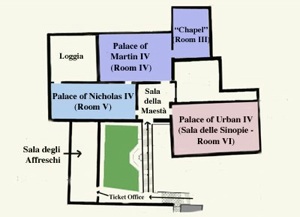
Sala degli Affreschi
This room on the left, at the top of the lower staircase, is below the episcopal library. It now houses the ticket office of the Museo dell’ Opera del Duomo and a collection of detached frescoes.
[3] Madonna dell’ Olivo (early 15th century)
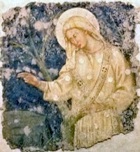
[6-8] Frescoes from Santa Maria del Carmine (ca. 1394)
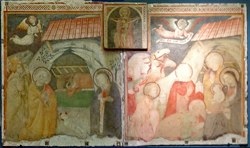
Pericle Perali (in his guide of 1919) mentions a fresco of the Annunciation to the right of the entrance of Santa Maria del Carmine, which was dated by inscription to 1394. He thought that it might be by Pietro di Puccio, but it has more recently been attributed to Andrea di Giovanni. [Is it still there ?] The fresco, which includes a donor portrait, probably formed part of a cycle of scenes from the early life of Christ.
Three detached frescoes in the Museo dell' Opera del Duomo, which are also attributed to Andrea di Giovanni, probably formed part of this cycle. They depict:
-
✴the nativity;
-
✴the adoration of the Magi; and
-
✴the presentation at the temple (fragmentary, not illustrated here).
They were transferred to the museum from the Oratorio di Santa Maria del Carmine, and had probably been detached from the walls of the church during its remodelling in ca. 1559.
A fourth fresco of the Trinity, which is exhibited with the first two of these frescoes as illustrated above, has the same provenance but is by a different artist.
[?] Fresco fragment (early 15th century)
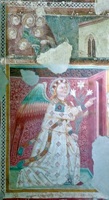
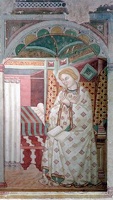
These elements of a fresco of the Annunciation came from Santo Spirito degli Armeni, a church outside Orvieto that was abandoned in the early 20th century.
Pietà with SS Faustinus and Peter Parenzo (1468)
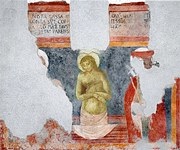
Pietro di Nicola Baroni was paid to paint this fresco in the Cappellina dei Corpi Santi of the Cappella Nuova of the Duomo in 1468. The inscription above, which is in two columns, commemorates St Faustinus and St Peter Parenzo, intercessors for the city, whose bodies lay in the “cassa dei corpi santi” (a new wooden sarcophagus) in the chapel. It reads:
IN ISTA CASSA R[E]
CONDITA SUNT CORP[O]
RA SANCTORUM MARTIRUM FAUST
[INI] ET PETRY PARENS[I]
QUORUM MERITIS INTER
CESSIONIBUS DEUS [CIVITATEM]
HANC [ELUIT] [...]
The fresco, which depicted the two saints flanking an image of the Pietà, was covered by a wall in 1502-3, but partially recovered and detached during the restoration of the chapel in 1996.
Sala della Maestà
This room at the top of the entrance staircase was originally an open loggia, with entrances to the three palaces that form the complex. The arch in the right wall, which looked down on the inner courtyard, was closed in the 16th century. The trifore windows belong to the palace of Pope Martin IV (ahead) and that of Pope Nicholas IV (on the left).
Maestà (early 14th century)
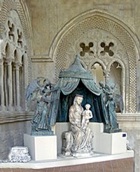
-
✴a marble statue of the Madonna and Child enthroned;
-
✴a cast bronze canopy, and
-
✴two groups of three cast bronze angels who draw back the canopy drapes.
The Madonna probably pre-dates the canopy and six angels, which were cast in 1325. At least two of the angels were decorated in 1330. Traces of blue on the underside of the canopy survive, as do the marks left by the application of stars made of gold leaf. The casting of such a complex group is a remarkable feat for this period. The “jewels” around the edge of the canopy are a later addition, and the limbs of the figures have been replaced or heavily restored.



